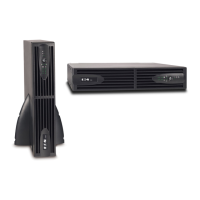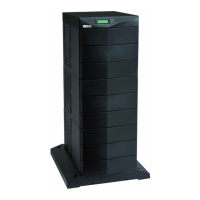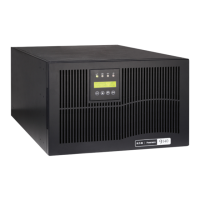Eaton Power Xpert 9395 UPS Installation and Operation Manual 164201764—Rev 14 5
UPMs will go to bypass instead of just the UPM needing service, decreasing critical load protection. With dual
auxiliary MOBs, one UPM can be bypassed while the remaining UPMs support the load as long as the
remaining UPMs have the capacity to do so.
11..22..77 IInnppuutt OOuuttppuutt MMoodduullee CCoonnffiigguurraattiioonn
The UPS can be supplied in an Input Output Module (IOM) configuration without the bypass input connections,
the static switch, the motorized wraparound bypass breaker, and the backfeed protection contactor. This
configuration is primarily used in multiple UPS parallel systems that do not need a bypass for each UPS and use
a separate System Bypass Module (SBM) to provide system bypass capabilities.
11..22..88 CCoonnttiinnuuoouuss SSttaattiicc SSwwiittcchh
A continuous static switch is used to provide transfer of the load from the inverter to the bypass source in the
event the inverter become unavailable. The continuous static switch eliminates the need for an additional
motorized wraparound bypass breaker.
11..22..99 IInnhheerreenntt RReedduunnddaannccyy
To deliver greater reliability, the Power Xpert 9395 UPS can be configured by an authorized Eaton Customer
Service Engineer for inherent redundancy if a FI-UPM is installed. When configured, the UPS automatically
becomes redundant if the load is at or below the capacity of the UPMs minus the capacity of one UPM. Under
normal conditions the UPMs in the UPS share the load equally. If one or more UPMs becomes unavailable and
the load is at or below the capacity of remaining UPMs, the remaining UPMs supply the load instead of
transferring to bypass.
If the capacity of the UPMs falls below the redundancy level or the load increases above redundancy level, but
is still able to maintain the load, a loss of redundancy alarm is sounded. If the load exceeds the capacity of
remaining UPMs, the UPS transfers to bypass.
11..22..1100 EEnneerrggyy SSaavveerr SSyysstteemm aanndd HHiigghh AAlleerrtt MMooddeess
NOTE Energy Saver System mode requires the UPS to be factory built with a Continuous Static
Switch (CSS).
NOTE The Variable Module Management System and Energy Saver System modes are
mutually exclusive.
As a subset of Online mode, the Energy Saver System (ESS) mode maximizes efficiency by eliminating
unnecessary power conversion when the commercial power source is within acceptable voltage and frequency
limits. In this mode, the UPS is actively monitoring the critical bus and instantly and seamlessly transitions to
double-conversion mode (inverter online) if a commercial electrical power brownout, blackout, overvoltage,
undervoltage, or out–of–tolerance frequency condition occurs.
In High Alert mode the unit transfers from ESS mode to double-conversion mode or if in double-conversion
mode remains in double-conversion mode for a default time period of one hour. High Alert mode allows the
user to place the unit in double-conversion mode when outside conditions could cause a power disturbance. At
the completion of the time period, the unit defaults back to ESS mode. If the High Alert command is received
during the time period, the timer will be restarted.
11..22..1111 HHaarrmmoonniicc RReedduuccttiioonn SSyysstteemm ((HHRRSS))
The Harmonic Reduction system mode of the 9395 UPS allows the UPS to actively reduce the input Total
Demand Distortion (TDD) and increase the input power factor while maintaining high efficiency operation in
ESS mode. The UPS uses one of its UPMs to perform this active harmonic cancellation.
HRS mode uses an extra set of sensors (CTs) on the output bus of the unit. These sensors measure the
harmonics created by loads attached to the UPS output and the system actively reduces these harmonics.
Introduction

